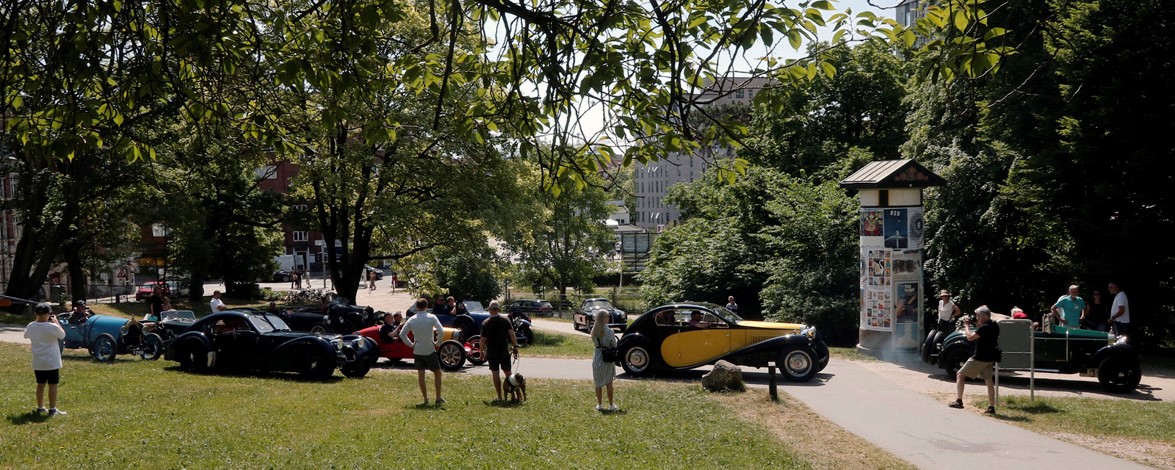A selection og Bugatti types
Bugattis named his cars and other designs with type numbers. The numbers were assigned chronologically to the cars as they were developed, so they are not related to the years in which they were developed.
Type 13 - became Bugatti's first production model, over the years made in several variants (types 15, 17, 22 and 23, etc.). In the period 1910 - 1926 about 2,400 of these types were produced. From 1919 the 4-cylinder engine was available with 4 valves per cylinder, and the racing version with 16 valves became especially famous for the 1-2-3-4 win in the 1921 Brescia race.
Type 18 and 21 - was a large 5-liter racing car, manufactured in 1912-1914 in only seven copies. The engine had three valves per cylinder and made 90 HP. The type performed well in mountain runs, but the engine lubrication was insufficient for long 500 miles races, including some in the United States.
Type 30 – this car met Bugatti's ambition of producing a larger 8-cylinder car. The engine of 2 litres and three valves per cylinder presented for the first time Bugatti's completely angular engine design. Around 600 type 30 cars were built 1922 – 1926. Some early ones were of the racing variant type 29/30.
Type 35 – the new Grand Prix racer for 1924 showed Ettore Bugatti's superb sense of design including the new alloy wheels. The engine was a stronger version of type 30, which first delivered 90 HP, and later with compressor 130 HP. In the years 1924 - 1931 some 200 type 35 were produced, in addition to 130 of a simpler 8-cylinder 2 litres version, designated type 35A.
Type 37 - similar to the type 35 racer except for the use of wire wheels. It had a new 4-cylinder engine of 1.5 litres. The engine produced 60 HP and in the type 37A version with compressor up to 90 HP. 290 type 37 cars were built 1926 - 1930. Now a Bugatti was affordable to more drivers, so the type 37 participated in many local races.
Type 38 - replaced the type 30 and was also aimed at the buyers of sporting luxury cars. The engine was still an 8-cylinder 2-litres engine of 70 HP, and the chassis now showed all the Bugatti hallmarks, such as the elegantly forged front axle with the springs led through. 385 cars of type 38 were built in the years 1926 - 1927.
Type 40 – followed after the type 23 and used a 4-cylinder engine of 1.5 litres, same as in the type 37. Type 40 offered all the Bugatti qualities at a competitive price. In the years 1926 - 1930, Bugatti built 830 type 40 cars, 40 of which were type 40A with the slightly larger engine block from – half of - the 8-cylinder type 49 engine.
Type 41 - 'Royale' was the realization of Ettore Bugatti's old dream of offering a car that clearly surpassed the famed luxury cars of Rolls Royce. The gigantic car had an 8-cylinder 12 litres engine and a 4.3 m wheelbase. Bugatti planned for building 25 type 41 cars, but due to the economic depression since 1929 the luxury automobile market had declined, so only 6 cars were built. They all exist today.
Type 43 - Bugatti's most powerful and full-blooded late 1920s’ sports car was built in a number of 160 over the years 1927-1932. The engine was similar to the one in the 8-cylinder 2.3 litres type 35B Grand Prix racer. With a weight of only about 1,100 kg and an engine power of 120 HP, the lucky buyer of a type 43 would own the absolute super sports car of those years.
Type 44 – took over after the type 38, so it was a touring car in the luxury class. The 8-cylinder engine with 3 litres capacity was of a new construction, still with a single overhead camshaft. 'The Buick of Molsheim' it was called, and in the years 1927-1930 almost 1,100 type 44 cars were produced.
Type 46 - was for the wealthy customers who could not afford a 'Royale' or just wanted a luxury car of a reasonable size. The engine was an 8-cylinder of 5.4 litres. It provided 140 HP, or 160 HP if it was one of the few type 46S with compressor. About 400 type 46 cars were built in the years 1929 - 1936.
Type 49 – succeeded the type 44 and became Bugatti's last car type with the 8-cylinder single overhead camshaft engine layout. A refined and comfortable touring car of which 470 were built in the years 1930-1934. Most of them featured a body from one of the esteemed French makers of bodywork.
Type 50 - showed that Ettore Bugatti could be inspired by other designers, in this case American Harry Miller. Its 5-litres engine thus had two overhead camshafts and only two valves per cylinder, giving a massive output of 200 HK. Only 65 type 50s were produced in the years 1930-1934.
Type 51 – was based on the type 35 Grand Prix racer, but now powered by a compressor-charged, double overhead camshafts engine, providing 160-180 HP. Only 40 type 51 cars were built during 1931 – 1935. Today it is considered the most efficient race car built in Ettore Bugatti's time.
Type 52 – designated 'Baby' was originally a children’s half-scale version of the type 35, built in 1926 as a birthday present for Bugatti's youngest son Roland. With electric motor and four-wheel brakes, it quickly came into demand by Bugatti's customers worldwide. Probably a few hundred type 52 were built.
Type 55 - was an elegant 2-seater sports car, mostly known with the factory's own bodywork in American roadster style, designed by Ettore Bugatti's oldest son Jean. The engine was a slightly downgraded version of the 2.3 litres type 51 engine, which provided 130 HP. Only 38 of the type 55 were built in 1932 - 1935.
Type 57 - became Bugatti's last successful and sporting luxury car in 1934 – 1940, resulting in 630 cars produced. The engine was a new 3.3 litres construction with double overhead camshafts, giving 135 HP as standard, and with compressor 160 HP. Bugatti also built 40 cars of the type 57S with a lower chassis and typically clothed in very smart bodywork.
Type 59 – was Bugatti's last classic Grand Prix racer. It used a type 57 engine in the 57SC compressor version. The wheels were unique in presenting piano spokes for lateral forces and teeth for acceleration and braking. However, the racing success failed, and only 6 or 7 type 59 were built in 1934 - 1936.
Type 101 - after the death of Ettore Bugatti in 1947 this model was Molsheim's last attempt in car production, based on a further development of the type 57 chassis and engine. The results were elegantly designed Grand Touring cars, but after the war the number of customers were few. Therefore, only a handful came out of the factory during the years 1951 - 1953.



